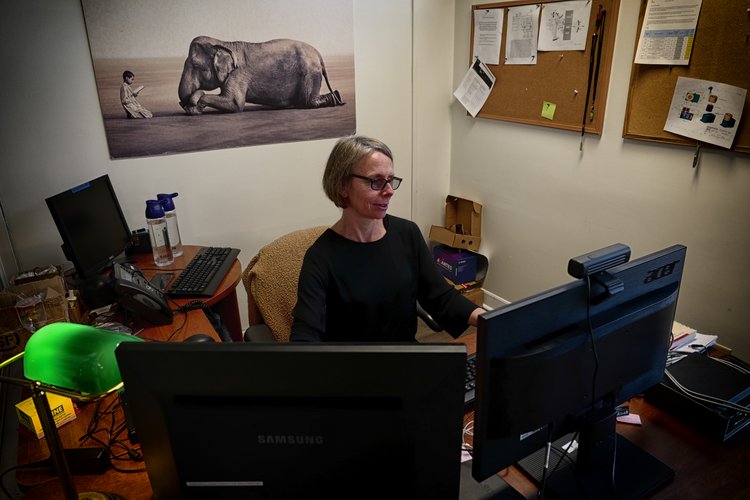Examine This Report on Uv/vis/nir
Examine This Report on Uv/vis/nir
Blog Article
More About Uv/vis/nir
Table of ContentsCircularly Polarized Luminescence - QuestionsThe Of Uv/visUv/vis - The FactsThe 3-Minute Rule for Circular DichroismThe Basic Principles Of Circularly Polarized Luminescence The Greatest Guide To Circular Dichroism8 Easy Facts About Circularly Polarized Luminescence ShownThe Best Strategy To Use For Circularly Polarized LuminescenceCircularly Polarized Luminescence - TruthsSome Of Circularly Polarized LuminescenceFascination About Uv/visCircular Dichroism - QuestionsUnknown Facts About Circularly Polarized Luminescence
It is then scanned through the sample and the recommendation solutions. Fractions of the occurrence wavelengths are transferred through, or reflected from, the sample and the referral. Electronic circuits transform the relative currents into linear transmission portions and/or absorbance/concentration values.The transmission of a referral substance is set as a standard (information) value, so the transmission of all other substances are tape-recorded relative to the initial "zeroed" compound. The spectrophotometer then converts the transmission ratio into 'absorbency', the concentration of specific components of the test sample relative to the preliminary substance.
Since samples in these applications are not easily offered in big quantities, they are especially fit to being evaluated in this non-destructive strategy. In addition, precious sample can be conserved by utilizing a micro-volume platform where as low as 1u, L of sample is needed for complete analyses. A short explanation of the procedure of spectrophotometry consists of comparing the absorbency of a blank sample that does not contain a colored substance to a sample that contains a colored compound.
Circular Dichroism Things To Know Before You Get This
In biochemical experiments, a chemical and/or physical home is chosen and the treatment that is used specifies to that property in order to derive more details about the sample, such as the quantity, purity, enzyme activity, etc. Spectrophotometry can be used for a number of methods such as determining ideal wavelength absorbance of samples, determining ideal p, H for absorbance of samples, figuring out concentrations of unknown samples, and identifying the p, Ka of numerous samples.: 21119 Spectrophotometry is also a practical process for protein purification and can likewise be used as a method to create optical assays of a compound.
It is possible to understand the concentrations of a 2 component mix utilizing the absorption spectra of the basic solutions of each element. To do this, it is essential to know the extinction coefficient of this mixture at two wave lengths and the termination coefficients of options that consist of the known weights of the two elements.

All about Spectrophotometers
Area. The concentration of a protein can be approximated by measuring the OD at 280 nm due to the presence of tryptophan, tyrosine and phenylalanine.
Nucleic acid contamination can also interfere. This technique needs a spectrophotometer efficient in measuring in the UV area with quartz cuvettes.: 135 Ultraviolet-visible (UV-vis) spectroscopy involves energy levels that delight electronic shifts. Absorption of UV-vis light excites particles that are in ground-states to their excited-states. Visible area 400700 nm spectrophotometry is used extensively in colorimetry science.
20. 8 O.D. Ink producers, printing companies, fabrics vendors, and much more, need the information supplied through colorimetry. They take readings in the area of every 520 nanometers along the visible region, and produce a spectral reflectance curve or an information stream for alternative presentations. These curves can be used to evaluate a new batch of colorant to check if it makes a match to requirements, e.
Things about Spectrophotometers
Traditional visible area spectrophotometers can not find if a colorant or the base material has fluorescence. This can make it hard to handle color issues if for example one or more of the printing inks is fluorescent. Where a colorant consists of fluorescence, a bi-spectral fluorescent spectrophotometer is used (https://pblc.me/pub/3fc0b3e264b77b). There are two major setups for visual spectrum spectrophotometers, d/8 (spherical) and 0/45.
Scientists utilize this instrument to determine the amount of compounds in a sample. In the case of printing measurements two alternative settings are frequently see post used- without/with uv filter to manage much better the impact of uv brighteners within the paper stock.
Some Ideas on Uv/vis You Should Know
Some applications need little volume measurements which can be carried out with micro-volume platforms. As described in the applications area, spectrophotometry can be utilized in both qualitative and quantitative analysis of DNA, RNA, and proteins. Qualitative analysis can be utilized and spectrophotometers are used to tape-record spectra of compounds by scanning broad wavelength areas to figure out the absorbance properties (the intensity of the color) of the compound at each wavelength.

Some Known Incorrect Statements About Spectrophotometers
One significant aspect is the kind of photosensors that are available for different spectral regions, however infrared measurement is also difficult since virtually everything discharges IR as thermal radiation, specifically at wavelengths beyond about 5 m. Another complication is that several products such as glass and plastic absorb infrared, making it incompatible as an optical medium.
Retrieved Dec 23, 2018. Fundamental Lab Techniques for Biochemistry and Biotechnology (2nd ed.). The necessary guide to analytical chemistry.
Oke, J. B.; Gunn, J. E.
Little Known Facts About Spectrophotometers.

1021/ac50048a728. ISSN0003-2700. Ninfa AJ, Ballou DP, Benore M (2015 ). Basic Lab Methods for Biochemistry and Biotechnology (3, rev. ed.). Hoboken, NJ: Wiley & Sons. p. 77. ISBN9780470924525. OCLC915641828. "Totally Automatic Double Beam - Atomic Absorption Spectrophotometer (AA 8000)". Lab Devices. Labindia Analytical Instruments Pvt. Ltd. "Spectrophotometry Applications and Fundamentals".
The Ultimate Guide To Spectrophotometers
"Applied Spectrophotometry: Analysis of a Biochemical Mixture". Biochemistry and Molecular Biology Education. Journal of Biochemistry Education.
A Biased View of Circularly Polarized Luminescence
U.S. Department of Commerce National Bureau of Standards unique publication; 378. Washington, D.C.: U.S. National Bureau of Standards.
The procedure begins with a controlled light that brightens the evaluated sample. In the case of reflection, as this light interacts with the sample, some is taken in or given off. The given off light travels to the detector, which is analyzed, quantified, and provided as industry-standard color scales and indices.
All terms are evaluated over the noticeable spectrum from 400 to 700 nm. In the case of transmission, when the light connects with the sample, it is either taken in, reflected, or sent.
Spectrophotometers Fundamentals Explained
Examples include APHA (American Public Health Association) for watercolor and pureness analysis, ASTM D1500 for petrochemical color analysis, edible oil indices utilized in food, and color analyses of beverages. The simplified mathematics appears like this:. Where T is the transmission coefficient. All terms are assessed over the visible spectrum from 400 to 700 nm.
Image Credit: Matej Kastelic/ Dr. Arnold J. Beckman and his colleagues at the National Technologies Laboratories initially created the spectrophotometer in 1940. In 1935 Beckman founded the business, and the discovery of the spectrophotometer was their most ground-breaking development. Dr. Bruce Merrifield, a Nobel prize-winning biochemist, mentioned that the innovation of the spectrophotometer was "probably the most crucial instrument ever established towards the advancement of bioscience." Before the discovery of the spectrophotometer, chemical analyses took weeks to finish, with 25% precision.
See This Report on Uv/vis
Over time, scientists kept enhancing the spectrophotometer design to boost its performance. The UV abilities of the model B spectrophotometer were enhanced by replacing the glass prism with a quartz prism.
After 1984, double-beam variations of the device were created. The addition of external software with the provision of onscreen displays of the spectra can be found in the 1990s. Generally, a spectrophotometer is comprised of 2 instruments, namely, a spectrometer and a photometer. A standard spectrophotometer contains a light, a monochromator, a collimator for straight beam transmission, a cuvette to put a sample, and a photoelectric detector.
Circularly Polarized Luminescence - Truths
There are various kinds of spectrophotometers in various sizes and shapes, each with its own purpose or performance. A spectrophotometer figures out just how much light is shown by chemical components. UV/Vis/NIR. It measures the distinction in light intensity based on the overall amount of light presented to a sample and the amount of light beam that travels through the sample solution
As per the instrument's design, the sample is put in between the spectrometer and the photometer. After the light is passed through the sample, the photometer measures its intensity and displays the reading. A spectrophotometer is used to identify the concentration of both colorless and colored solutes in an option. This instrument is utilized to figure out the rate of a response.
Report this page